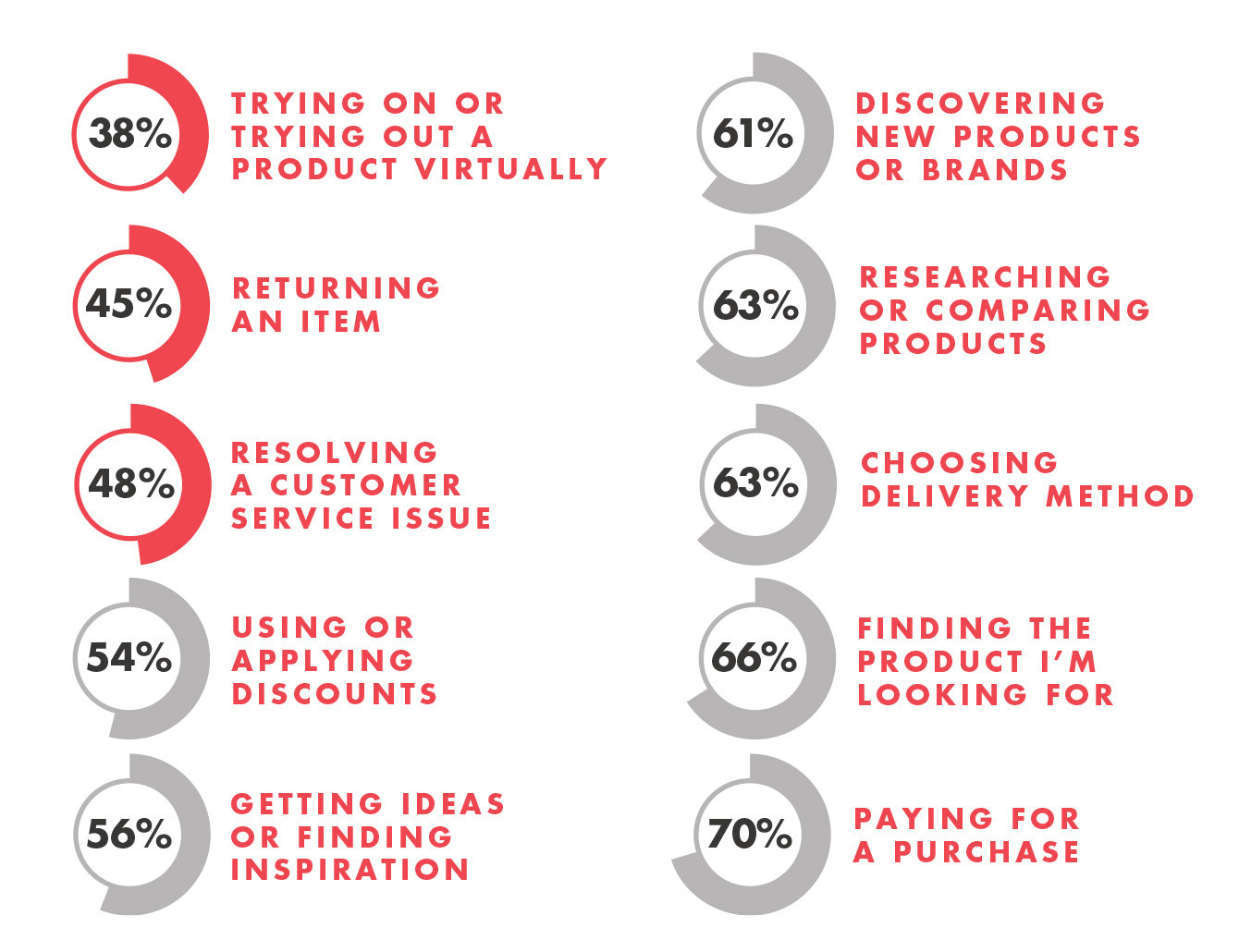Let’s face it—returns aren’t great for anyone. For shoppers, it’s a moment of dissatisfaction and another process to go through. For retailers, it’s a burden—one with costs that go beyond the initial sticker price.
In 2020, $428 billion in merchandise was returned, approximately 10.6 percent of total U.S. retail sales. According to the National Retail Federation, the rate of online returns more than doubled when compared to 2019, with $102 billion in e-commerce returns alone.
In some cases, returned items are unable to be resold or are resold at a lower price, cutting into profits. Additional shipping places the onus on logistics, ensuring items get routed to the right destination, whether that be a warehouse, a physical store, or a landfill. These last-mile hurdles result in greenhouse gas emissions from increased delivery traffic and packaging waste, with the e-commerce market projected to produce upwards of 4 billion pounds of plastics by 2025—a different type of cost entirely.
Sign up to read the full report
Sign up

An estimated 5 billion pounds of goods end up in U.S. landfills annually.
It’s estimated returns volume will grow to more than $1 trillion in merchandise annually over the next several years. Considering that an estimated 15 to 40 percent of e-commerce orders are returned (nearly three times the rate of brick-and mortar-returns), retailers risk leaving even more on the table if returns aren’t managed efficiently.
Today’s shopper expects online returns to be seamless and preferably free. A profitable returns management system requires retailers to consider how they can use data to improve customer experience alongside operational efficiency.

“The returns process is critical to the overall customer experience, so if you focus only on minimizing costs you could create a big issue from a sales perspective. Retailers must balance cost impact with sales impact and brand impact as they’re thinking about optimizing the return process.”
— Guy Elliott, retail lead, North America, Publicis Sapient
STEP ONE
Get ahead of returns by truly knowing the customer
One of the biggest differences between e-commerce and brick-and-mortar is the ability for consumers to try on or try out products. Consumer research from Publicis Sapient finds that retailers struggle to replicate this digitally.
Sixty-two percent of shoppers aren’t satisfied with the ability to try-on and try-out products online. And when people don’t feel confident in what they’re buying, it can lead to returns that retailers could have prevented with better customer experience.
The ability to try on or try out products online, manage returns and resolve customer service issues are rated the lowest among satisfaction across the digital customer journey. Nearly half of consumers look for an easy way to manage returns when choosing online retailers.
Percent Satisfied or Very Satisfied with doing the following activities online

In apparel, nearly half of U.S. shoppers will buy multiple sizes of a product online with the intention of returning items that don’t fit. This behavior, known as “bracketing,” is a way for shoppers to ensure they get the right product through trial and error– something that could be perceived as low-risk when returns are free.
“Providing as much information about products as possible upfront can help generate consumer confidence,” Elliott said. “You can actually start to drive down costs by not having to ship three items and take two back, which is going to cause you a loss in almost every case.”
Data is key to helping customers make better purchase decisions, says Andy Halliwell, senior client partner, Publicis Sapient. That starts on the product page.
“You need data about the product, the product information, the data around how people are buying it and how people are returning it, so that you can feed that into the upfront customer experience,” he said. In the case of apparel, “use data to your advantage and help make sure that from the start it fits, so a shopper doesn’t actually need to return it.”
Customer data can also be used to identify shoppers with a high likelihood to return. Retailers can then incentivize these customers towards more cost-effective return methods, like returning in-store or at a click-and-collect location.
“Retailers can segment customers and products based on returns history and promote or suppress marketing efforts based on the customer profile and product attributes,” Nitin Dsouza, director, strategy and transformation, Publicis Sapient, said.
Limiting the number of items a customer can buy in different sizes helps avoid the need to discount unwanted products. Adding dynamic pricing on shipping in these cases can incentivize customers to choose the best option for them, while also covering potential losses on returns. For seasonal items, incentivizing customers to return quickly could also be effective.
“Some of the investments that we've started to see have been around using AI and ML to make better predictions based on where shoppers are returning from, and some of their options, like where retailers need that product and how quickly they can have it ready for the next customer. All of this plays a role in driving higher profitability,” Hilding Anderson, head of retail strategy, North America, Publicis Sapient, said.
And then, there’s the in-store experience. According to Halliwell, “retailers are going to have to start thinking about having a dedicated space where digital sales can be brought back into stores, designed with transactions in mind.” This could be by implementing new experiences, like strategically placing a café near queues where customers can wait comfortably, or equipping associates with the right digital tools to manage customer returns on the floor. Digitally, retailers can offer personalized in-store deals to incentivize consumers who choose to return or exchange at their local retail location.
“If you can take the return and immediately sell them the right product, you both minimize your cost of the return and keep the sale,” Elliott said.
Retailers are already using data to get smarter about helping their customers. AI-driven personalization tools like TrueFit ask shoppers to enter basic information about height and weight, along with brands they’ve shopped with before where they know their size. The tool then recommends similar sizes, so shoppers understand how different sizing translates across brands. Other retailers use a combination of user reviews and personalization to make recommendations by matching past preferences to what similar shoppers have purchased.
Augmented reality lets shoppers “place” at item in their home virtually or “try-on” products through photo or video. Livestream demos and chatbots allow shoppers to interact directly with staff and ask questions before they buy.
“The ability to field questions backs up performance promises, delivering the assurance users need to make a big-ticket purchase online, and ultimately reduces costly returns for the retailer,” Britta Alexander, director of experience, retail, Publicis Sapient, said.
STEP TWO
Mitigate the cost of returns with operational efficiency
While improved customer experience may prevent unnecessary returns from happening, operational efficiency is what will ultimately mitigate cost when returns do inevitably happen. Visibility and predictability into the supply chain across vendors, transport providers, distribution, stores and dealers are key to unlocking actionable insights.
“If your reverse logistics are not up to scratch, then it’s going to be really tough to hit the levels of profitability that most retailers are used to,” Halliwell said.
Speed to resale on returned items is critical to maximize margins. Improved inventory visibility lets retailers effectively streamline distribution by routing products to the right place at the right time. This requires a de-siloed data system, with information shared across the supply chain to determine the best economic opportunity for redistribution.
Retailers can also get ahead of mail-in returns by dynamically printing shipping labels that routes the return to the best distribution point and providing them to the consumer – streamlining shipping while also cutting down on packaging waste.
“There are retailers who are spending huge amounts of money flying product between warehouses to try to get product into the right space,” Halliwell said. “But if you’ve got 1,000 returns, and it goes directly to the warehouse that doesn’t have any in stock, you can eliminate that step.”
Optimizing returns requires blending cost-effective measures with customer-centric experiences. With data and a modernized, digitally forward supply chain, retailers can make intelligent decisions on how to manage returns seamlessly and effectively.
